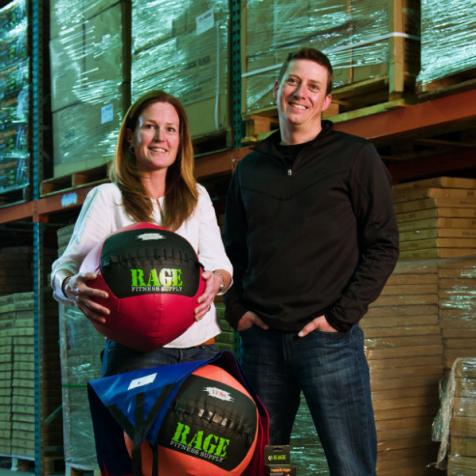
Company Details
Location
Denver
Founded
1972
Ownership Type
Private
Employees
90
Products
Fitness Centers
Denver
www.gibsonathletic.com / www.ragefitness.com
Founded: 1972
Privately owned
Employees: About 90
Healthy turn: Tamara and Brian Smith’s ‘phoenix from the ashes’ is now a growing manufacturer in the global fitness market
Husband and wife Brian and Tamara Smith, now Gibson's respective CEO and Chief Strategy Officer, bought the company in 2006.
"I had two criteria," says Brian. "I wanted to be in the athletic space and I wanted to be in manufacturing. We touch a lot of people's lives with our products, and that's a key driver for me."
The company had nine employees at the time and $1.5 million in annual revenue as a longstanding presence in the institutional gymnastics and ballet markets, making beams, pads, and other equipment. It hit 90 employees and $12.5 million last year. Brian expects to top $15 million in 2014, and the company continues to hire. "We expect to be at about 100 employees at the end of the year."

Describing the comeback since as "a phoenix from the ashes” scenario, Brian says the company was at a crossroads in the early days of the Smiths' ownership.
"When we bought the business, we had no idea the economy was going to take a downturn," says Brian. The couple was immediately facing tough decisions. "We could either lay our staff off or go into new product development and new channel creation."
They took the latter approach in the form of the company's RAGE Fitness brand, launched by the Smiths in 2008.
RAGE hit the sweet spot of a major boom in CrossFit gyms and other "functional movement” fitness, including boot camps and mixed martial arts. There were about 60 CrossFit locations when the brand launched. Now there are more than 10,000 worldwide.
As the trend has moved into the mainstream, so has the RAGE brand. It's now available at a number of national chains and counts numerous national fitness centers as customers. The brand also now represents the lion's share of Gibson's revenue. "Last year, RAGE leapfrogged Gibson [in terms of sales]," says Brian. Which is really saying something -- gymnasts wore Gibson products at the 2012 Olympics.
Gibson's overall catalog has grown considerably thicker, with about 3,500 SKUs in all. Besides RAGE and Gibson, the company also has a third brand, Moving Mountains, making equipment for the occupational therapy market.
”We're very diverse," says Brian, a serial entrepreneur who's worked in the sandwich industry with Quizno's and telecom with Qwest. "All three brands resonate in functional movement."
"We are experts in wood, steel, cut-and-sew textiles, plastic, and foam," says Brian. "If you can imagine a foam pad around a unique item, we can create it."

Gibson works with a national and global supply chain "to get the right product to the right customer at the right time," he adds. About two-thirds of the company's product (from a revenue standpoint) is made in Denver, with products ranging from ring sets to barbells to foam pads to kettlebells.
"I look at our facility as an incubator rather than a high-volume production facility," says Brian. "If we're not creating and innovating new products, we become stale."
Case in point: a unique new soft Atlas stone, traditionally made from concrete, RAGE debuted last year. "Sitting in a product development meeting, out of humor we said, 'How about we make a medicine ball on steroids?’" says Brian. "Within 24 hours, we had the first 22-inch soft Atlas stone on the market."
The company is also now working with outside inventors, many of them from the CrossFit community, and licensing their concepts. The goal is to make "the next great fitness product," says Brian. "We can enable dreams to become reality."
Describing a Shark Tank-like selection process, Brian says, "For every 50 ideas that come to us, we probably only accept three, and only one becomes relevant. It's got to be meaningful to a large customer base."
To date, the company has inked a royalty-based deal with an inventor that developed the "world's fastest speed jump rope," and has several similar deals in the works.
"The takeaway is we want to encourage and embrace a community of people who are very excited and passionate about fitness," says Brian. "It creates a flywheel effect where we can become the incubator."

Challenges: "Continuing to meet the demands of an ever-changing market and staying ahead of the curve," says Brian. "Sometimes I wish we made just one product on one assembly line. In the space we're in, we've got to be constantly innovating and creating new stuff." Smith credits Gibson's staff, including recent hires like COO Bob Hirnieson, VP of Finance Ken Cales, and Brand & Marketing Director LaRae Marsik.
Opportunities: Continued growth as CrossFit and other functional fitness exercises go mainstream. "When we're sitting there with big-box buyers, it's an honor to be across from them” says Brian.
Another opportunity: International growth, particularly for the RAGE Fitness brand. "This is the first year CrossFit is growing faster internationally than domestically," says Brian, citing the UK, Germany, Columbia, Brazil, South Africa, Australia, and Japan as top international markets.
Needs: "If I was speaking to the president and the governor, I would tell them to look at putting some programs in place to encourage manufacturing in the United States," says Brian. "There's a tipping point -- at some point, you have to look at a global supply chain. But there are ways the government could make some changes and bring some of those jobs back."
He says people need to rethink "an already slanted purchasing perception," noting, "Everybody is very proud to buy 'Made in America' until they go to the cash register."
